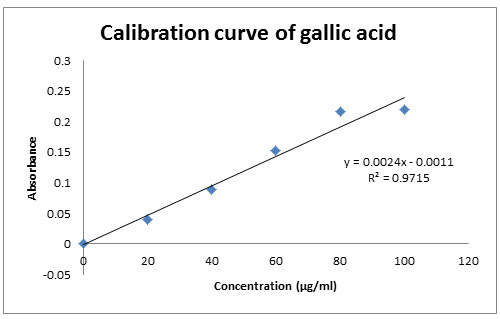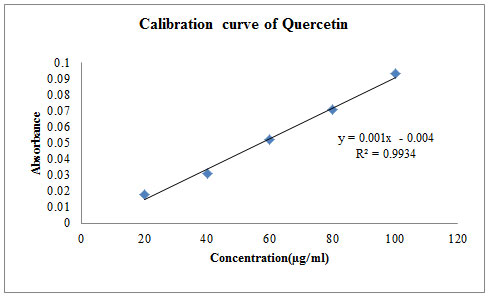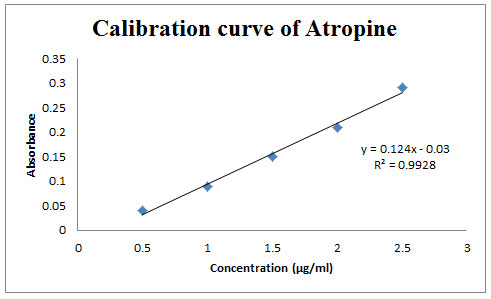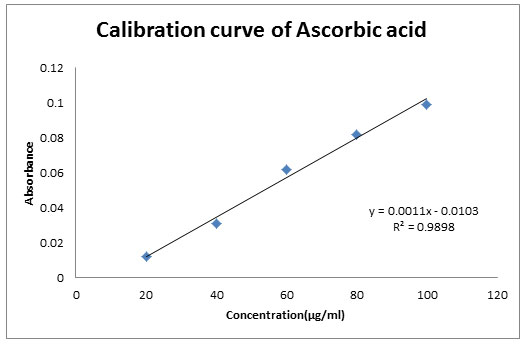Department of Pharmacology, Raghavendra Educational and Rural Development Society (RERDS), RIPER-Autonomous Campus, Ananthapuramu, Andhra Pradesh, India- 515721.
Corresponding author email: somu.reddyvaru@gmail.com
Article Publishing History
Received: 13/05/2020
Accepted After Revision: 24/06/2020
Tuberculosis is an infectious disease that kills approximately three million people annually worldwide. This high incidence of infection and the increased rate of multi-drug resistance and extensively drug resistance strains of the organism further complicated the problem of TB control and have called for an urgent need to develop new anti tuberculosis drugs from plants. The present study is aimed to evaluate the phytochemical investigation and anti mycobacterial activity of Solanum pubescens. Preliminary phytochemical analysis is done both methanolic and ethyl acetate extracts of leaves of Solanum pubescens. Both the extracts were subjected with estimation of total phenolic content, total flavonoid, total alkaloid and total antioxidant activity. The phenolic content, flavonoid content, alkaloid content and in vitro anti-oxidant potential of methanolic extract was found to be 46.33±13.23, 29.66 ± 8.08, 1.46±0.26 and 48.33±12.11 respectively. The phenolic content, flavonoid content, alkaloid content and in vitro anti-oxidant potential of ethyl acetate extract was found to be 38.33±11.23, 23.43 ±5.05, 1.24±0.16 and 43.66±9.07 respectively. Methanolic and ethyl acetate extracts were assessed for anti mycobacterial activity against mycobacterium tuberculosis using H37RV strain. Methanolic extract of leaves of Solanum pubescens exhibited very good anti tuberculosis activity having minimum inhibitory concentration of 6.25µg/ml. The ethyl acetate extract of Solanum pubescens having minimum inhibitory concentration of 10µg/ml. Furthermore work is required to be undertaken for active principle or group of compounds responsible for such activity.
Anti-oxidant activity, Antimycobacterial activity, Solanum pubescens
Mahesh E. U, Reddy K. S, Kavery T, Sudheer A, Sree P. L, Lakshmiprasanna P. Phytochemical Investigation and Anti Mycobacterial Activity of Solanum pubescens. Biosc.Biotech.Res.Comm. 2020;13(2).
Mahesh E. U, Reddy K. S, Kavery T, Sudheer A, Sree P. L, Lakshmiprasanna P. Phytochemical Investigation and Anti Mycobacterial Activity of Solanum pubescens. Biosc.Biotech.Res.Comm. 2020;13(2). Available from: https://bit.ly/2MEWbyT
Copyright © Mahesh et al., This is an open access article distributed under the terms of the Creative Commons Attribution License (CC-BY) https://creativecommns.org/licenses/by/4.0/, which permits unrestricted use distribution and reproduction in any medium, provide the original author and source are credited.
INTRODUCTION
Tuberculosis (TB) continues to be one of the leading infectious causes of death in the world especially in a developing and densely populated country like India, (Rajesh Archana et al., 2017). Mycobacterium tuberculosis is a pathogenic organism which causes Tuberculosis (Ravindran et al., 2020). TB, an old disease that has plagued humankind for centuries, is known to be a highly infectious disease and still remains the leading killer among infectious diseases in the world (Aro et al 2019). Although anti-TB drugs have been in existence for many years, the disease continues to be prevalent. The primary reason behind this is the emergence of drug-resistant strains of Mtb. Thus, although several drugs are available, the quest for newer and more effective ones continues (Sarkar et al., 2020).
The indigenous plant resources provide medications to alleviate cough and related respiratory disorders associated with TB ( Sieniawska et al., 2020). Moreover, higher plant extracts have been considered as promising sources of novel anti-TB leads (Kahaliw et al., 2017). Traditionally Solanum pubescens has been used in treatment of head ache, menstrual pain, rheumatoid arthritis, tuberculosis, ulcers, liver disorders, diarrheal disease and cancer disorder. But there is unavailable scientific data of Solanum pubescens against tuberculosis. The present study is undertaken to explore the preliminary phytochemical analysis and antimycobacterial activity of Solanum pubescens.
MATERIAL AND METHODS
Plant collection: Fresh leaves of Solanum pubescens, family Solanaceae were collected from Kadiri, Ananthapuramu district, Andhrapradesh state, India. Identification & authentication: Solanum pubescens was identified and authenticated by Dr. J. Raveendra Reddy, M. Pharm, Ph. D, Raghavendra Institute of Pharmaceutical Education and Research [RIPER], Ananthapuramu district, Andhrapradesh state, India.Chemicals: The chemicals were used in this study were obtained from Hi-Media Pvt. Ltd.Extraction procedure: The powdered plant material was weighed using analytical balance and prepared for solvent extraction. Successive extraction was done using 300g of powdered material of leaves in soxhlet apparatus. The solvents ethyl acetate (2L, 70˚C, 15-17 cycles) and methanol (2L, 70˚C, 15-17 cycles) were used (Fatemeh SR et al., 2014).
Phytochemical screening: The methanolic extract of Solanum pubescens (MESP) and ethyl acetate extract of Solanum pubescens (EAESP) were subjected to phytochemical screening Borokini TI et al., 2012).
Estimation of total phenolic content (TPC):Folin ciocalteu’s assay is used for the determination of total phenolic content of the extracts. The 1ml of extract or standard solution of Gallic acid at concentration of 20, 40, 60, 80, 100mg/ml is added to the 25ml of volumetric flask which is already containing 9ml of distilled deionized water. To the above solution added 1ml of Folin- ciocalteus reagent and shaken it well. Added 10 ml of 7% Sodium carbonate solution after 5min to the above solution. The above solution is diluted by using 25ml of water and mixed it. Incubated the solution for 90 min at room temperature, absorbance was determined at 750 nm using UV-Visible spectrophotometer. The total phenolic content was expressed in units as milligrams of Gallic acid equivalents[GAE] per 100 grams dry mass[mg GAE/100MG] (Tab sum, SH et al., 2016).
Estimation of total flavonoid content (TFC):Colorimetric assay is used for the determination of total flavonoids content. The 1ml of extract and standard solutions of quercetin at concentrations of 20, 40, 60, 80, 100mg/ml was added to the 10ml volumetric flask already containing 4ml distilled water. To the above solution added 0.3 ml of 5% Sodium nitrate. Then added 0.3 ml of 10% Alcl3 after 5min and 6 min, added 2ml of 1M NaOH and total volume made up to 10 ml with distilled water. The whole solution was mix up and absorbance was measured at 510 nm in UV- Visible spectrophotometer. The data of the total flavonoid content was expressed as milligrams of quercetin equivalents [QE] per 100g dry mass [mg QE/100g] (Tabsum et al., 2016).
Estimation of total alkaloid content (TAC):TAC was also quantified by spectrophotometric method. This method is based on the reaction between alkaloid and bromocresol green [BCG]. The plant extract [1mg/ml] was dissolved in 2 N HCL and then filtered. The PH of phosphate buffer solution was adjusted to neutral with 0.1 N NaOH. 1ml of this solution was transferred to a separating funnel, and then 5ml of BCG solution along with 5ml phosphate buffer were added. The mixture was shaken and the complex formed was extracted with chloroform by vigorous shaking. The extract was collected in a 10 ml volumetric flask and diluted to volume with chloroform. The absorbance of the complex in chloroform was measured at 470 nm (Islam et al., 2013)
Total antioxidant activity: The antioxidant activity of the extracts was evaluated by the phosphor-molybdate method using ascorbic acid as a standard. The assay is based on the reduction of Mo [4]-Mo [5] by the extract and subsequent formation of green phosphate/ Mo[5] complex at acidic ph. An aliquot of 0.3 ml. extract was combined with 3ml of reagent solution [0.6M sulfuric acid, 28mM sodium phosphate and 4mM ammonium molybdate]. The tubes containing the reaction solution were incubated at 95degree centigrade for 90 min. After the samples had cooled to room temperature, the absorbance of the solution was measured at 695 nm against blank using a spectrophotometer. Methanol [0.3ml] in the place of extract is used as the blank. Ascorbic acid equivalents were calculated using standard graph of ascorbic acid (Lourenco, et al., 2007)
In vitro anti tuberculosis activity:The anti mycobacterial activity of compounds were assessed against M. tuberculosis using micro plate Alamar Blue assay [MABA]. This methodology is non toxic, uses a thermally stable reagent and shows good correlation with proportional and BACTEC radiometric method. Briefly, 200 micro liters of sterile deionized water was added to all outer perimeter wells of sterile 96 wells plate to minimized evaporation of medium in the test wells during incubation. The 96 wells plate received 100 micro liters of the Middle brook 7H9 broth and serial dilution of compounds were made directly on plate. The final drug concentrations tested were 100 to 0.2 micro gram per ml. plates were covered and sealed with parafilm and incubated at 37ᵒC for5 days. After this time, 25µl of freshly prepared 1:1 mixture of almar blue reagent and 10% tween 80 was added to the plate and incubated for 24hrs. A blue colour in the well was interpreted as no bacterial growth, and pink colour was scored as growth. The MIC was defined as lowest drug concentration which prevented the colour change from blue to pink, (Lourenco et al., 2007).
RESULTS AND DISCUSSION
Tuberculosis is a chronic disease caused by mycobacterium tuberculosis. Tuberculosis has been major health problem for developing countries including India. Tuberculosis is still a serious illness and a serious public health problem with medical, sociological and economic consequence that has a fatal end in more than 50% of untreated cases. The increase in multi drug resistance and extensively drug resistance strains of mycobacterium tuberculosis, there is an urgent need of finding newer anti-mycobacterial agents to combat this problem (Ngadino et al., 2018).
In the current study the focus was to assess the phytochemical screening and antimycobacterial activity of methanolic and ethyl acetate extracts of leaves of Solanum pubescens. The physical appearance of methanolic and ethyl acetate extracts of leaves of Solanum pubescens was found to be green in colour, semisolid and pleasant odour. The methanolic extract of Solanum pubescens examined for phytochemical analysis and they contained the alkaloids, flavonoids, tannins, phenolic compounds and glycosides where as ethyl acetate extract of Solanum pubescens consisted of alkaloids, flavonoids, tannins, phenolic compounds, steroids and saponins. Both the extracts were subjected for quantification of the total phenolic content, total flavonoid content, total alkaloid content and total antioxidant activity.
The content of the phenolic compounds in the methanolic extract of leaves of Solanum pubescens is expressed in gallic acid equivalents was 46.33±13.22. The content of flavonoid compounds in methanolic extract of leaves of Solanum pubescens is expressed in quercetin equivalents was 29.66 ± 8.087. The content of alkaloid compounds in methanolic extract of leaves of Solanum pubescens is expressed in atropine equivalents was 1.463±0.268. The content of total antioxidant activity of methanolic extract of leaves of Solanum pubescens is expressed in ascorbic acid equivalents was 48.33±12.11. The content of total phenolic compounds in ethyl acetate extract of leaves of Solanum pubescens is expressed in Gallic acid equivalents was 38.33±11.23.
The content of flavonoid compounds in ethyl acetate extract of leaves of Solanum pubescens is expressed in quercetin equivalents was 23.43±5.057. The content of alkaloid compounds in ethyl acetate extract of leaves of Solanum pubescens is expressed in atropine equivalents was 1.246±0.168. The content of total antioxidant activity of ethyl acetate extract of leaves of Solanum pubescens is expressed in ascorbic acid equivalents was 43.66±9.0.
Table 1. Physical appearance of extracts of Solanum pubescens
| S. No. | Physical appearance | Result | |
| MESP | EAESP | ||
| 01 | Color | Green | Green |
| 02 | Texture | Semi solid | Semi solid |
| 03 | Odour | Pleasant | Pleasant |
| 04 | % Yield | 10% | 8% |
Table 2. Phytochemical screening of Solanum pubescens
| S. No | Test | MESP | EAESP |
| 01 | Alkaloids | + | + |
| 02 | Flavonoids | + | + |
| 03 | Phenolic compounds | + | + |
| 04 | Tannins’ | + | + |
| 05 | Steroids | + | + |
| 06 | Saponins | + | – |
| 07 | Glycosides | + | – |
+ indicates present, – indicates absent
Figure 1: Estimation of Total Phenolic content (Graph 1: Calibration curve of Gallic acid)
Figure 2: Estimation of total flavonoid content (Graph 2. Calibration curve of Quercetin)
Figure 3: Estimation of total Alkaloid content (Graph 3: Calibration curve of Atropine)
Figure 4: Total anti-oxidant activity (Graph 4: Calibration curve of ascorbic acid)
Table 3. Total TPC, TFC, TAC, contents of methanolic extract of Solanum pubescens
| Name of the plant | : | Solanum pubescens |
| Family | : | Solanaceae |
| Parts used | : | Leaves |
| Extract investigated | : | Methanolic |
| TPC (mg of GAE/gm) | : | 46.33±13.23 |
| TFC(mg of QE/gm) | : | 29.66±8.087 |
| TAC(mg of /gm) | : | 1.463±0.268 |
| Total antioxidant activity | : | 48.33±12.11 |
Each value represents the mean ± S.E.M.(n=5).GAE=Gallic acid equivalents, QE= Quercetin equivalents.
Table 4. Total TPC, TFC, TAC, contents of ethyl acetate extract of Solanum pubescens
| Name of the plant | : | Solanum pubescens |
| Family | : | Solanaceae |
| Parts used | : | Leaves |
| Extract investigated | : | Ethyl acetate extract |
| TPC (mg of GAE/gm) | : | 38.33±11.23 |
| TFC(mg of QE/gm) | : | 23.43±5.057 |
| TAC(mg of /gm) | : | 1.246±0.168 |
| Total antioxidant activity | : | 43.66±9.07 |
Each value represents the mean± S.E.M.(n=5) GAE= Gallic acid equivalents, QE= Quercetin equivalents
Table 5. Anti TB Activity of Methanolic extract by using MABA
| Samples(µg/ml) | Mycobacterium tuberculosis | |
| 0.8 | : | R |
| 1.6 | : | R |
| 3.12 | : | R |
| 6.25 | : | S |
| 12.5 | : | S |
| 25 | : | S |
| 50 | : | S |
| 100 | : | S |
Table 6. Anti TB Activity of Ethyl acetate extract by using MABA
| Samples(µg/ml) | Mycobacterium tuberculosis | |
| 1.2 | : | R |
| 2.5 | : | R |
| 5 | : | R |
| 10 | : | S |
| 20 | : | S |
| 40 | : | S |
| 80 | : | S |
| 100 | : | S |
The anti-mycobacterial activity of methanolic and ethyl acetate extract of leaves of Solanum pubescens is evaluated by micro plate alamar blue assay using H37RV, a standard strain of Mycobacterium tuberculosis. The plant extracts showed anti mycobacterial activity to different extents but methanolic extract of leaves of Solanum pubescens exhibited good anti tuberculosis activity having minimum inhibitory concentration of 6.25µg/ml. The ethyl acetate extract of Solanum pubescens having minimum inhibitory concentration of 10µg/ml (Showed in table 6 and 7). Furthermore work is required to be undertaken for active principle or group of compounds responsible for such activity.
CONCLUSION
The methanolic extract of Solanum pubescens was shown to be very active as is quite evident from its MIC of 6.25µg/ml. The actual compound responsible for activity needs to be identified
ACKNOWLEDGEMENTS
The authors express sincere thanks to the DST-FIST lab, Raghavendra Institute of Pharmaceutical Education and Research (RIPER), for providing necessary facilities to carry out the research work
Conflicts of Interest
The authors declare no conflict of interest
REFERENCES
Rajesh, NG., Archana, DJ.,(2017). Anti-mycobacterial Activity of Selected Indian Botanicals Using Surrogate Mycobacterium Strains. Natural Products Chemistry & Research., 5, 279-284.
Ravindran, R., Chakrapani, G., Mitra, K., Doble, M., (2020). Inhibitory activity of traditional plants against Mycobacterium smegmatis and their action on Filamenting temperature sensitive mutant Z (FtsZ)—A cell division protein. PLoS ONE., 15(5), 1-21.
Aro, AO., Dzoyem, JP., Goddard, A., Fonteh, P., Kayoka-Kabongo, PN., and McGaw, LJ.,(2019). In vitro Antimycobacterial, Apoptosis-Inducing Potential, and Immunomodulatory Activity of Some Rubiaceae Species. Frontiers in Pharmacology.,10 (185),1-13.
Sarkar, A., Ghosh, S., Shaw, R., Patra, MM., Calcuttawala, F., Mukherjee, N., et al. (2020). Mycobacterium tuberculosis thymidylate synthase (ThyX) is a target for plumbagin, a natural product with antimycobacterial activity. PLoS ONE., 15(2), 1-16.
Elwira,Sieniawska., Magdalena, Maciejewska-Turska, Łukasz, Świątek., Jianbo, Xiao.,(2020). Plant-based Food Products for Antimycobacterial Therapy.EFood., 2666-3066.
Wubayehu, Kahaliw., Abraham, Aseffa., Markos Abebe, Mekonen Teferi., and Ephrem, Engidawork., (2017). Evaluation of the antimycobacterial activity of crude extracts and solvent fractions of selected Ethiopian medicinal plants BMC Complementary and Alternative Medicine., 17:143-151.
Fatemeh, SR., Saifullah, R., Abbas, FM., Azhar, ME., (2014). Total phenolic, flavonoids and antioxidant activity of banana pulp and peel flours: influence of variety and stage of ripeness. International Food Research Journal.,19(3), 1041.
Borokini, TI., Omotayo, FO., (2012). Phytochemical and ethnobotanical study of some selected medicinal plants from Nigeria. Journal of Medicinal Plants Research., 6, 1106-1118.
Tab sum, SH., Khare, SW., (2016). Jain, KI. Spectrophotometric quantification of total phenolic, flavonoid and alkaloid contents of Abrus precatorius L. seeds. Asian Journal of Pharmacy & Clinical Research., 9(2), 371-4.
Islam, E., Islam, R., Rahman, AA., Alam, AK., Khondkar, P., Rashid, M., and Parvin, S.,(2013). Estimation of total phenol and in vitro antioxidant activity of Albizia procera leaves. BMC research notes., 6(1),121.
Lourenco, MC., de Souza, M., Pinheiro, AC., Ferreira, MD., Gonçalves, RS., Nogueira, TC., Peraltaz, MA.,(2007). Evaluation of anti-tubercular activity of nicotinic and isoniazid analogues. ARKIVOC., 15, 181-91.
Ngadino, S., Koerniasari, E., SA S (2018). Evaluation of Antimycobacterial activity of Curcuma xanthorrhiza ethanolic extract against Mycobacterium tuberculosis H37Rv in vitro. Veterinary world 11(3), 368.






